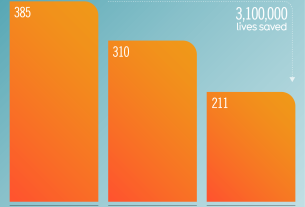|
Getting your Trinity Audio player ready...
|
“The compulsory wearing of safety belts, as well as helmets for two-wheelers, and increased political commitment to road safety, played a decisive role in the reduction of road deaths throughout Europe from the 1970s onwards,” said Jean Todt, UN Special Envoy for Road Safety.
Using safety belts by front-seat passengers reduces the risk of fatal injuries by 45 to 50 per cent and the risk of death and serious injuries among back-seat occupants by 25 per cent, according to the World Health Organization (WHO).
UN regulation saving lives
Technical specifications of seat belt use and installation stem from UN Regulation No. 16, which entered into force in 1970. In the following years, a growing number of countries introduced legislation to make the use of seat belts in vehicles compulsory.
Currently, 105 countries have seat belt laws aligned with best practices, according to the latest WHO Global Status Report on Road Safety.
Decline in road fatalities
Seat belts remain the best vehicle safety device to protect passengers from being severely injured in a crash or being ejected from the vehicle, according to the UN Economic Commission for Europe (UNECE), which hosts the Special Envoy’s office and the UN Road Safety Trust Fund, launched in 2018.
Over the past several decades regulation and consumer demand have led to increasingly safe cars in higher income countries, in turn leading to fewer road fatalities, according to UNECE.
For example, in Europe, total road fatalities decreased by 15 per cent in between 2000 and 2010, and by 15 per cent between 2010 and 2019. In particular, this drop was more significant among car occupants, UNECE said.
According to the International Transport Forum Road Safety Annual Report 2022, the period between 2010 and 2019 saw a marked drop in the number of car occupant road deaths in developed countries, especially in Greece, where fatalities dropped by 63 per cent, and in the Republic of Korea, where they fell by 51 per cent.
SDG 3: Target 3.6 aims at halving the number of global deaths and injuries from road traffic accidents by 2030.
The report noted that reductions of fatalities by more than 30 per cent were recorded in another 13 countries: Argentina, Australia, Belgium, Denmark, Ireland, Luxembourg, Lithuania, Portugal, Slovenia, Spain, Sweden, and Switzerland.
Buckle up elsewhere
However, too many countries around the world still need to enact appropriate legislation requiring drivers and passengers to wear seat belts and to enforce stricter compliance, according to UNECE.
Some 1.35 million people still die on the roads every year.
A total of 93 per cent of vehicular deaths occur in developing countries.
“We now must work with governments and all relevant industry stakeholders to ensure that people in the developing world enjoy the same level of safety as those in developed countries,” the Special Envoy said.
That means adopting and enforcing laws in line with international standards and providing access to vehicles, both new and used, with appropriately fitted seat belts, he said.
Custodian of crashworthiness
UN Regulation No. 16 is the only widely internationally recognized requirement for seat belt use in vehicles. It defines the requirements an effective seat belt must comply with and tests for their certification to keep all occupants safe, from children to elderly people.
The UN regulation requires a seat belt to carry an approval mark on the buckle tongue, while other models must display an encircled capital letter E followed by a number that represents the country whose certified authority granted its approval.
Seat belts approved according to Regulation No. 16 are tested under the most severe conditions to endure ageing and to function together with other safety systems, including airbags, as part of the complete vehicle crashworthiness.
Currently, 52 nations have joined the 1958 Agreement on Harmonized Technical UN Regulations for Wheeled Vehicles, which apply Regulation No. 16 as national law. Several other countries worldwide are also applying this regulation with certain changes.
Aside from seat belts, UN regulations to protect vehicle passengers and other road users include airbags, electronic stability control, pedestrian protection, and child restraint anchorage points.
Learn how the UN helps to save lives in low and middle-income countries here.
Buckling down on safety
Since UN Regulation No. 16 entered into force on 1 December 1970 and started a drive towards improving road safety, here are some of the countries that joined the race to save lives:
🚗 France in 1973
🚗 Spain in 1974
🚗 Netherlands, Norway, and Sweden in 1975
🚗 Germany in 1976
🚗 Canada (Ontario) in 1976
🚗 Portugal in 1978
🚗 Switzerland in 1981
🚗 United Kingdom in 1983
🚗 Poland in 1983
🚗 United States (New York) in 1984
🚗 Russia in 1987
🚗 Italy in 1988
🚗 China in 1993
Zambia: Creating Safer Cities for All Road Users Including Children



